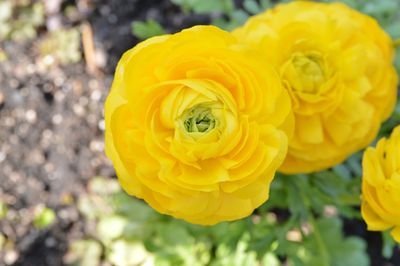Propagating Persian Buttercups
Another beautiful contribution from Persia to our blooming gardens, Persian buttercup plants (Ranunculus asiaticus) are easy to grow in the right conditions. Hardy in USDA zones 7-10, gardeners find they are a beautiful addition to the late spring or early summer flower garden. Plantings in zone 7 benefit from winter mulch. In more northern zones, you may maintain the same plant for years if you dig, divide and store the bulbs for winter. Alternatively, treat the plant as an annual in your sunny flowerbed. Note: The bulbs of ranunculus are actually tubers. This is a common misspeak and really not much different from bulbs. Tubers usually spread and multiply more quickly than bulbs and are a little tougher. When purchasing seeds or tubers, keep in mind there are both tall varieties for cutting gardens and shorter types better suited to containers.
Dividing Persian Buttercup Plants
You can propagate Persian buttercups by dividing the tubers and removing offsets in autumn. This is the most common method of propagation. Originating from the eastern Mediterranean region, Persian buttercups are not winter hardy north of USDA zone 7. If you are in zone 7 or above, you can simply replant the divisions in fall in different areas or in containers for an abundance of long-lasting blooms next spring. Those in northern zones should place their tubers in dry storage in vermiculite or peat over winter. When replanting in spring, soak the tubers in warm water for an hour or so. Then plant the tubers 2 inches (5 cm.) deep with the claws downward. Be sure to plant in soil with excellent drainage to avoid root rot. The plant won’t grow in heavy clay soil. Water in well when planting.
Starting Persian Buttercup Seeds
Start this beautiful bloom from seeds, if you prefer. Some sources believe fresh seeds are the ideal way to start these flowers. Seeds germinate best in daytime temps of 60 to 70 degrees F. (15-21 C.) and nighttime temps of 40 F. (4 C.). When these conditions are available, get the seeds started. Moisten seed starting soil and place in a plug tray, biodegradable containers, or the seed-starting container of your choice. Locate seeds on top of the soil and place in an area away from direct sun and drafts. Keep the soil evenly moist. When propagating Persian buttercup seeds, germination usually takes place within 10-15 days. Seedlings with four or more true leaves are ready for transplant to other containers, allowing for additional growth before moving them to the garden bed. Plant them outside when danger of frost has passed. Producing peony-like flowers that bloom in spring, ranunculus dies off when summer temperatures move consistently into the 90-degree F. (32 C.) range. Enjoy bountiful blooms multiplying in the garden until then.
